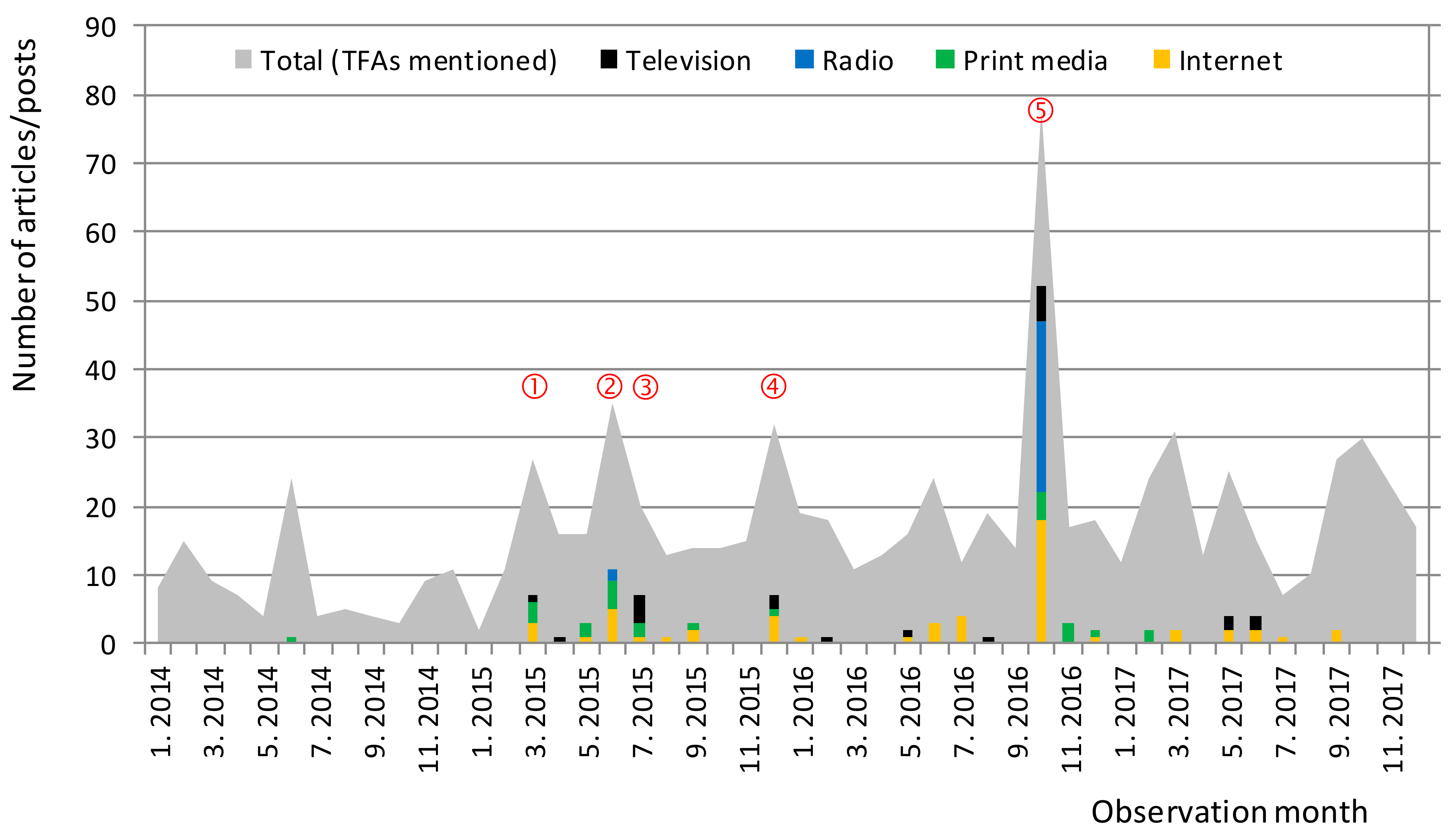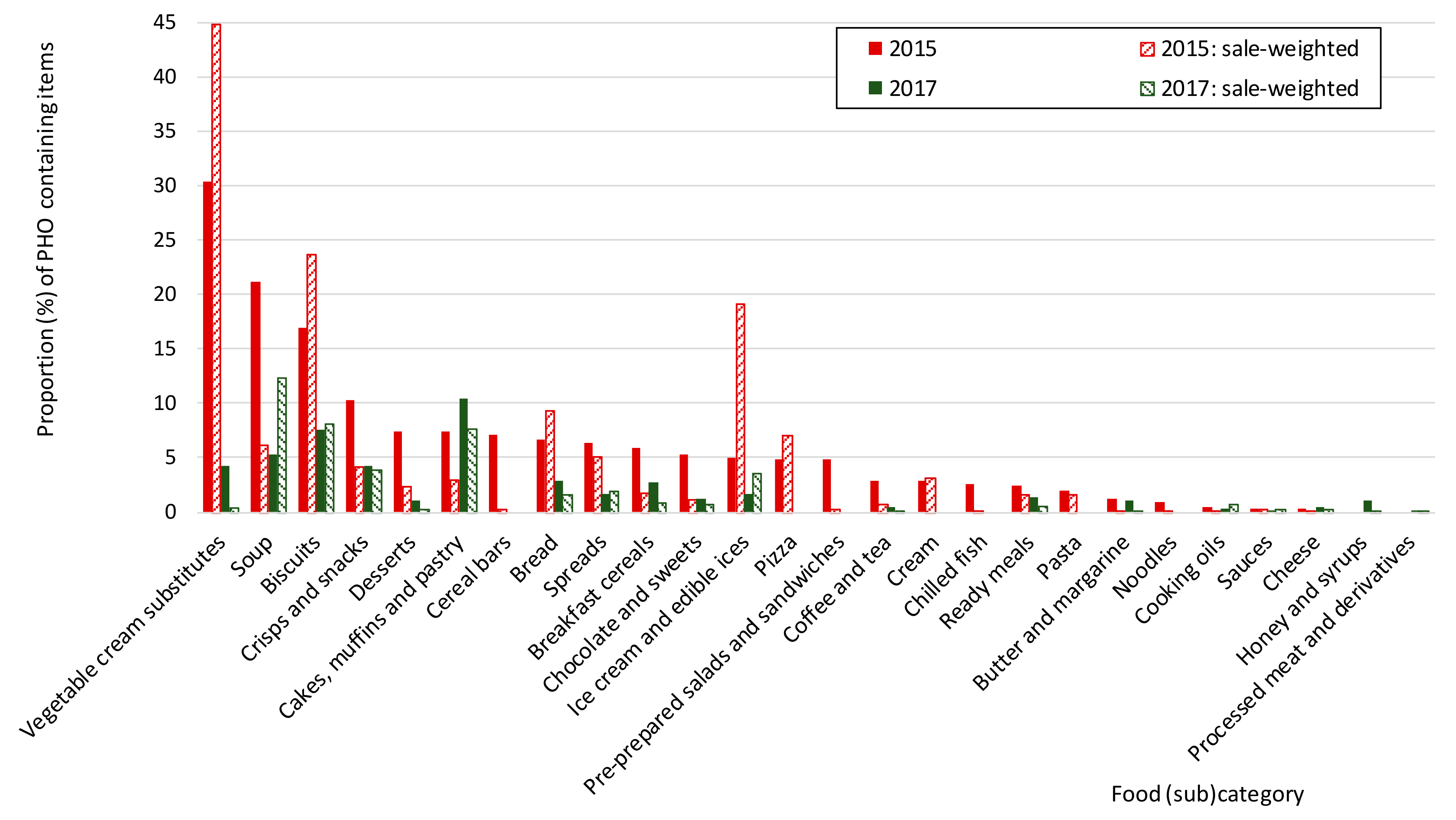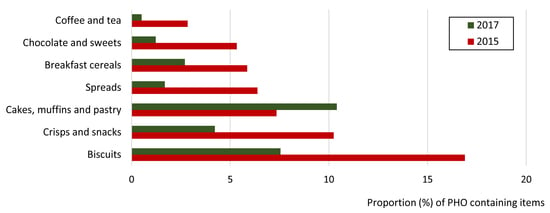Limiting trans Fats in Foods: Use of Partially Hydrogenated Vegetable Oils in Prepacked Foods in Slovenia
Abstract
:1. Introduction
2. Experimental Section
2.1. Data Collection
2.2. Data Analysis
3. Results
4. Discussion
5. Conclusions
Supplementary Materials
Acknowledgments
Author Contributions
Conflicts of Interest
References
- Micha, R.; Mozaffarian, D. Trans fatty acids: Effects on metabolic syndrome, heart disease and diabetes. Nat. Rev. Endocrinol. 2009, 5, 335–344. [Google Scholar] [CrossRef] [PubMed]
- MacGibbon, A.; Taylor, M. Composition and structure of bovine milk lipids. In Advanced Dairy Chemistry Volume 2 Lipids; Springer: Berlin, Germany, 2006; pp. 1–42. [Google Scholar]
- Allison, D.B.; Egan, S.K.; Barraj, L.M.; Caughman, C.; Infante, M.; Heimbach, J.T. Estimated intakes of trans fatty and other fatty acids in the US population. J. Am. Diet. Assoc. 1999, 99, 166–174. [Google Scholar] [CrossRef]
- Mensink, R.; Zock, P.; Katan, M.; Hornstra, G. Effect of dietary cis and trans fatty acids on serum lipoprotein[a] levels in humans. J. Lipid Res. 1992, 33, 1493–1501. [Google Scholar] [PubMed]
- Willett, W.C.; Stampfer, M.J.; Manson, J.; Colditz, G.A.; Speizer, F.E.; Rosner, B.A.; Hennekens, C.H.; Sampson, L.A. Intake of trans fatty acids and risk of coronary heart disease among women. Lancet 1993, 341, 581–585. [Google Scholar] [CrossRef]
- Oomen, C.M.; Ocké, M.C.; Feskens, E.J.; van Erp-Baart, M.-A.J.; Kok, F.J.; Kromhout, D. Association between trans fatty acid intake and 10-year risk of coronary heart disease in the Zutphen Elderly Study: A prospective population-based study. Lancet 2001, 357, 746–751. [Google Scholar] [CrossRef]
- Hu, F.B.; Stampfer, M.J.; Manson, J.E.; Rimm, E.; Colditz, G.A.; Rosner, B.A.; Hennekens, C.H.; Willett, W.C. Dietary fat intake and the risk of coronary heart disease in women. N. Engl. J. Med. 1997, 337, 1491–1499. [Google Scholar] [CrossRef] [PubMed]
- Pietinen, P.; Ascherio, A.; Korhonen, P.; Hartman, A.M.; Willett, W.C.; Albanes, D.; Virtamo, J. Intake of fatty acids and risk of coronary heart disease in a cohort of Finnish men: The Alpha-Tocopherol, Beta-Carotene Cancer Prevention Study. Am. J. Epidemiol. 1997, 145, 876–887. [Google Scholar] [CrossRef] [PubMed]
- Ascherio, A.; Rimm, E.B.; Giovannucci, E.L.; Spiegelman, D.; Meir, S.; Willett, W.C. Dietary fat and risk of coronary heart disease in men: Cohort follow up study in the United States. BMJ 1996, 313, 84–90. [Google Scholar] [CrossRef] [PubMed]
- Kwon, Y. Effect of trans-fatty acids on lipid metabolism: Mechanisms for their adverse health effects. Food Rev. Int. 2016, 32, 323–339. [Google Scholar] [CrossRef]
- Brownell, K.D.; Pomeranz, J.L. The trans-fat ban—Food regulation and long-term health. N. Engl. J. Med. 2014, 370, 1773–1775. [Google Scholar] [CrossRef] [PubMed]
- Uauy, R.; Aro, A.; Clarke, R.; L’Abbé, M.; Mozaffarian, D.; Skeaff, C.; Stender, S.; Tavella, M. WHO Scientific Update on trans fatty acids: Summary and conclusions. Eur. J. Clin. Nutr. 2009, 63, S68–S75. [Google Scholar] [CrossRef]
- EFSA. Scientific Opinion on Dietary Reference Values for fats, including saturated fatty acids, polyunsaturated fatty acids, monounsaturated fatty acids, trans fatty acids, and cholesterol. EFSA J. 2010, 8, 1461. [Google Scholar]
- L’Abbé, M.R.; Stender, S.; Skeaff, C.; Tavella, M. Approaches to removing trans fats from the food supply in industrialized and developing countries. Eur. J. Clin. Nutr. 2009, 63, S50–S67. [Google Scholar] [CrossRef]
- Wilczek, M.M.; Olszewski, R.; Krupienicz, A. Trans-Fatty Acids and Cardiovascular Disease: Urgent Need for Legislation. Cardiology 2017, 138, 254–258. [Google Scholar] [CrossRef] [PubMed]
- Pravst, I. Trans fats: Towards a global ban on using partially hydrogenated oils. Agro Food Ind. Hi-Tech 2015, 26, 4. [Google Scholar]
- Lin, C.T.J.; Yen, S.T. Knowledge of Dietary Fats among US Consumers. J. Am. Diet. Assoc. 2010, 110, 613–618. [Google Scholar] [CrossRef] [PubMed]
- FDA. The FDA Takes Step to Remove Artificial trans Fats in Processed Foods. Available online: https://www.fda.gov/NewsEvents/Newsroom/PressAnnouncements/ucm451237.htm (accessed on 1 December 2018).
- Townsend, N.; Nichols, M.; Scarborough, P.; Rayner, M. Cardiovascular disease in Europe—Epidemiological update 2015. Eur. Heart J. 2015, 36, 2696–2705. [Google Scholar] [CrossRef] [PubMed]
- Buzeti, T.; Beznec, P.; Halozan, M.M.; Ohr, M. The capacity audit for addressing health inequalities and socioeconomic determinants of health-experiences from Slovenia. Eur. J. Public Health 2013, 23. ckt126.061. [Google Scholar] [CrossRef]
- Jasti, S.; Kovacs, S. Use of trans fat information on food labels and its determinants in a multiethnic college student population. J. Nutr. Educ. Behav. 2010, 42, 307–314. [Google Scholar] [CrossRef] [PubMed]
- Stender, S.; Astrup, A.; Dyerberg, J. Tracing artificial trans fat in popular foods in Europe: A market basket investigation. BMJ Open 2014, 4, e005218. [Google Scholar] [CrossRef] [PubMed]
- Stender, S.; Astrup, A.; Dyerberg, J. Artificial trans fat in popular foods in 2012 and in 2014: A market basket investigation in six European countries. BMJ Open 2016, 6, e010673. [Google Scholar] [CrossRef] [PubMed]
- Ministry of Health of Republic of Slovenia. Resolution on the National Programme on Nutrition and Physical Activity for Health 2015–2025; Ministry of Health: Ljubljana, Slovenia, 2015. Available online: http://www.mz.gov.si/fileadmin/mz.gov.si/pageuploads/javna_razprava_2015/Resolucija_o_nac_programu_prehrane_in_in_tel_dejavnosti_jan_2015.pdf (accessed on 15 March 2018).
- RTVSLO. “Tarča” Show: Trans Fats: Hidden, Dangerous, Legal (Broadcasted on Slovenian National Television on 16 July. 2015. Available online: http://4d.rtvslo.si/arhiv/tarca/174346818 (accessed on 1 December 2018).
- European Commission. Report from the Commission to the European Parliament and the Council Regarding trans Fats in Foods and in the Overall Diet of the Union Population. Available online: https://ec.europa.eu/food/sites/food/files/safety/docs/fs_labelling-nutrition_trans-fats-report_en.pdf (accessed on 1 December 2018).
- NUTRIS. Podatkovna Baza CLAS Kot Orodje za Vrednotenje Sprememb na Področju Ponudbe Predpakiranih Živil v Sloveniji. Available online: http://www.nutris.org/clas/ (accessed on 1 December 2018).
- Dunford, E.; Webster, J.; Metzler, A.B.; Czernichow, S.; Ni Mhurchu, C.; Wolmarans, P.; Snowdon, W.; L’Abbe, M.; Li, N.; Maulik, P.K.; et al. International collaborative project to compare and monitor the nutritional composition of processed foods. Eur. J. Prev. Cardiol. 2012, 19, 1326–1332. [Google Scholar] [CrossRef] [PubMed]
- Korošec, Ž.; Pravst, I. Assessing the average sodium content of prepacked foods with nutrition declarations: The importance of sales data. Nutrients 2014, 6, 3501–3515. [Google Scholar] [CrossRef] [PubMed]
- Pravst, I.; Kušar, A. Consumers’ exposure to nutrition and health claims on pre-packed foods: Use of sales weighting for assessing the food supply in Slovenia. Nutrients 2015, 7, 9353–9368. [Google Scholar] [CrossRef] [PubMed]
- Žmitek, K.; Pravst, I. Iodisation of Salt in Slovenia: Increased Availability of Non-Iodised Salt in the Food Supply. Nutrients 2016, 8, 434. [Google Scholar] [CrossRef] [PubMed]
- Stender, S.; Astrup, A.; Dyerberg, J. A trans European Union difference in the decline in trans fatty acids in popular foods: A market basket investigation. BMJ Open 2012, 2, e000859. [Google Scholar] [CrossRef] [PubMed]
- Abramovič, H.; Vidrih, R.; Zlatič, E.; Kokalj, D.; Schreiner, M.; Žmitek, K.; Kušar, A.; Pravst, I. Trans fatty acids in margarines and shortenings in the food supply in Slovenia. J. Food Compos. Anal. 2018, in press. [Google Scholar]
- Mozaffarian, D.; Stampfer, M.J. Removing industrial trans fat from foods. BMJ 2010, 340, c1826. [Google Scholar] [CrossRef] [PubMed]
- Downs, S.M.; Bloem, M.Z.; Zheng, M.; Catterall, E.; Thomas, B.; Veerman, L.; Wu, J.H. The impact of policies to reduce trans fat consumption: A systematic review of the evidence. Curr. Dev. Nutr. 2017, 1. [Google Scholar] [CrossRef]


© 2018 by the authors. Licensee MDPI, Basel, Switzerland. This article is an open access article distributed under the terms and conditions of the Creative Commons Attribution (CC BY) license (http://creativecommons.org/licenses/by/4.0/).
Share and Cite
Zupanič, N.; Hribar, M.; Pivk Kupirovič, U.; Kušar, A.; Žmitek, K.; Pravst, I. Limiting trans Fats in Foods: Use of Partially Hydrogenated Vegetable Oils in Prepacked Foods in Slovenia. Nutrients 2018, 10, 355. https://doi.org/10.3390/nu10030355
Zupanič N, Hribar M, Pivk Kupirovič U, Kušar A, Žmitek K, Pravst I. Limiting trans Fats in Foods: Use of Partially Hydrogenated Vegetable Oils in Prepacked Foods in Slovenia. Nutrients. 2018; 10(3):355. https://doi.org/10.3390/nu10030355
Chicago/Turabian StyleZupanič, Nina, Maša Hribar, Urška Pivk Kupirovič, Anita Kušar, Katja Žmitek, and Igor Pravst. 2018. "Limiting trans Fats in Foods: Use of Partially Hydrogenated Vegetable Oils in Prepacked Foods in Slovenia" Nutrients 10, no. 3: 355. https://doi.org/10.3390/nu10030355







